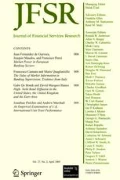Abstract
This paper compares the pricing of credit risk in the bond market and the fast-growing credit default swap (CDS) market. The cointegration test confirms that the theoretical parity relationship between the two credit spreads holds as a long-run equilibrium condition. Nevertheless, substantial deviation from the parity can arise in the short run. The panel data study and the VECM analysis both suggest that the deviation is largely due to the higher responsiveness of CDS premia to changes in credit conditions. Moreover, it exhibits a certain degree of persistence in that only 10% of price discrepancies can be removed within a business day.
Similar content being viewed by others
References
Acharya VV, Das SR, Sundaram RK (2002) Pricing credit derivatives with rating transitions. Financ Anal J 58:28–44
Anderson R, Sundaresan S, Tychon P (1996) Strategic analysis of contingent claims. Eur Econ Rev 40:871–881
Blanco R, Brennan S, March IW (2005) An empirical analysis of the dynamic relationship between investment-grade bonds and credit default swaps. J Finance 60:2255–2281
Campbell J, Taksler G (2003) Equity volatility and corporate bond yields. J Finance 58:2321–2349
Collin-Dufresne P, Goldstein R (2001) Do credit spreads reflect stationary leverage ratios? J Finance 56:1929–1957
Cossin D, Hricko T (2001) Exploring for the determinants of credit risk in credit default swap transaction data. Working Paper
Das SR (1995) Credit risk derivatives. J Deriv 2:7–21
Das SR, Sundaram RK (2000) A discrete-time approach to arbitrage-free pricing of credit derivatives. Manage Sci 46:46–62
Das SR, Sundaram RK, Sundaresan SM (2003) A simple unified model for pricing derivative securities with equity, interest-rate, and default risk. Working Paper, Santa Clara University
Davidson J, Hendry D, Srba F, Yeo S (1978) Econometric modelling of the aggregate time-series relationship between consumers’ expenditure and income in the United Kingdom. Econ J 88:661–692
Duffie D (1999) Credit swap valuation. Financ Anal J 55:73–87
Duffie D, Liu J (2001) Floating-fixed credit spreads. Financ Anal J 57:76–87
Duffie D, Singleton K (1999) Modeling term structures of defaultable bonds. Rev Financ Stud 12:687–720
Elton E, Gruber M, Agrawal D, Mann C (2001) Explaining the rate spread on corporate bonds. J Finance 56:247–277
Engle R, Granger C (1987) Co-integration and error correction: representation, estimation, and testing. Econometrica 55:251–276
Fitch IBCA (March 2003) Global credit derivatives: risk management or risk? Special report
Gonzalo J, Granger C (1995) Estimation of common long-memory components in cointegrated systems. J Bus Econ Stat 13:27–36
Houweling P, Vorst T (2005) Pricing default swaps: empirical evidence. J Int Money Financ 24:1200–1225
Hull J, White A (2000) Valuing credit default swaps I: no counterparty default risk. J Deriv 8(1):29–40
Hull J, White A (2001) Valuing credit default swaps II: modeling default correlations. J Deriv 8(3):12–22
Hull J, Predescu M, White A (2004) The relationship between credit default swap spreads, bond yields, and credit rating announcements. J Bank Financ 28:2789–2811
Jarrow RA, Turnbull SM (1995) Pricing derivatives on financial securities subject to credit risk. J Finance 50:53–85
Jarrow RA, Yildirim Y (2002) Valuing default swaps under market and credit risk correlation. J Fixed Income 11:7–19
Johansen S (1988) Statistical analysis of cointegrating vectors. J Econ Dyn Control 12:231–254
Johansen S (1991) Estimation and hypothesis testing of cointegrating vectors in Gaussian vector autoregressive models. Econometrica 59:1551–1580
Kalimipalli M, Warga A (2002) Bid/ask spread and volatility in the corporate bond market. J Fixed Income 82–91
Kocić A, Quintos C, Yared F (2000) Identifying the benchmark security in a multifactor spread environment. Lehman Brothers Fixed Income Derivatives Research Report
Leland HE (1994) Corporate debt value, bond covenants, and optimal capital structure. J Finance 49:1213–1252
Leland HE, Toft KB (1996) Optimal capital structure, endogenous bankruptcy, and the term structure of credit spreads. J Finance 51:987–1019
Liu J, Longstaff F, Mandell R (2005) The market price of credit risk: an empirical analysis of interest rate swap spreads. J Bus, forthcoming
Longstaff F, Schwartz E (1995) A simple approach to valuing risky fixed and floating rate debt. J Finance 50:789–820
Longstaff F, Mithal S, Neis E (2005) Corporate yield spreads: default risk or liquidity? New evidence from the credit default swap market. J Finance 60:2213–2253
Madan D, Unal H (2000) A two-factor hazard-rate model for pricing risky debt and the term structure of credit spreads. J Financ Quant Anal 35:43–65
Merton R (1974) On the pricing of corporate debt: the risk structure of interest rates. J Finance 29:449–470
Norden L, Weber M (2004) Informational efficiency of credit default swap and stock markets: the impact of credit rating announcements. J Bank Financ 28:2813–2843
Packer F, Zhu H (March 2005) Contractual terms and CDS pricing. BIS Q Rev, 89–100
Reinhart V, Sack B (2002) The changing information content of market interest rates. BIS Pap (12):340–357
Rule D (June 2001a) The credit derivatives market: its development and possible implications for financial stability. In: Financial Stability Review. Bank of England, pp 117–140
Rule D (December 2001b) Risk transfer between banks, insurance companies and capital markets: an Overview. In: Financial Stability Review. Bank of England, pp 137–159
Schönbucher PJ (2003) Credit derivatives pricing models: models, pricing, implementation. Wiley Finance
Author information
Authors and Affiliations
Corresponding author
Rights and permissions
About this article
Cite this article
Zhu, H. An Empirical Comparison of Credit Spreads between the Bond Market and the Credit Default Swap Market. J Finan Serv Res 29, 211–235 (2006). https://doi.org/10.1007/s10693-006-7626-x
Received:
Revised:
Accepted:
Published:
Issue Date:
DOI: https://doi.org/10.1007/s10693-006-7626-x




